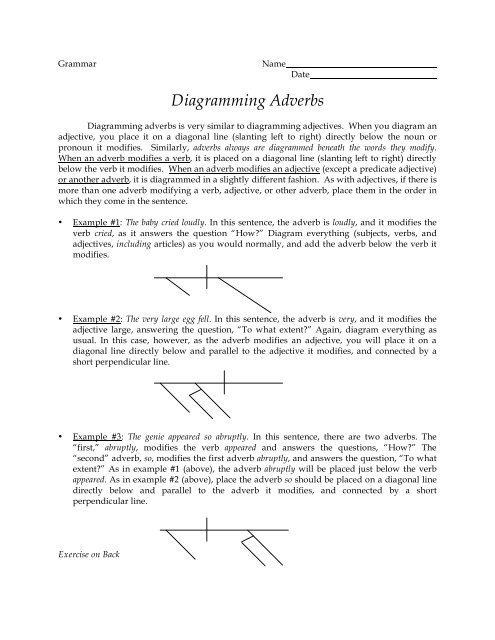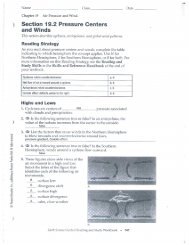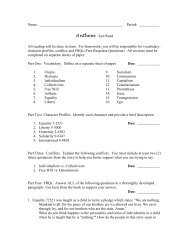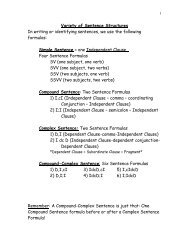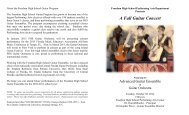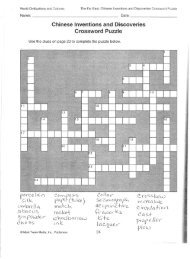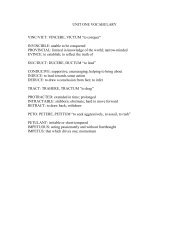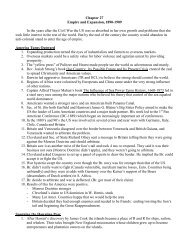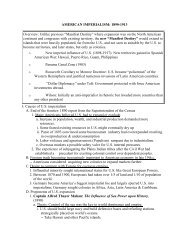Diagramming Adverbs
Diagramming Adverbs
Diagramming Adverbs
You also want an ePaper? Increase the reach of your titles
YUMPU automatically turns print PDFs into web optimized ePapers that Google loves.
Grammar<br />
Name<br />
Date<br />
<strong>Diagramming</strong> <strong>Adverbs</strong><br />
<strong>Diagramming</strong> adverbs is very similar to diagramming adjectives. When you diagram an<br />
adjective, you place it on a diagonal line (slanting left to right) directly below the noun or<br />
pronoun it modifies. Similarly, adverbs always are diagrammed beneath the words they modify.<br />
When an adverb modifies a verb, it is placed on a diagonal line (slanting left to right) directly<br />
below the verb it modifies. When an adverb modifies an adjective (except a predicate adjective)<br />
or another adverb, it is diagrammed in a slightly different fashion. As with adjectives, if there is<br />
more than one adverb modifying a verb, adjective, or other adverb, place them in the order in<br />
which they come in the sentence.<br />
• Example #1: The baby cried loudly. In this sentence, the adverb is loudly, and it modifies the<br />
verb cried, as it answers the question “How?” Diagram everything (subjects, verbs, and<br />
adjectives, including articles) as you would normally, and add the adverb below the verb it<br />
modifies.<br />
• Example #2: The very large egg fell. In this sentence, the adverb is very, and it modifies the<br />
adjective large, answering the question, “To what extent?” Again, diagram everything as<br />
usual. In this case, however, as the adverb modifies an adjective, you will place it on a<br />
diagonal line directly below and parallel to the adjective it modifies, and connected by a<br />
short perpendicular line.<br />
• Example #3: The genie appeared so abruptly. In this sentence, there are two adverbs. The<br />
“first,” abruptly, modifies the verb appeared and answers the questions, “How?” The<br />
“second” adverb, so, modifies the first adverb abruptly, and answers the question, “To what<br />
extent?” As in example #1 (above), the adverb abruptly will be placed just below the verb<br />
appeared. As in example #2 (above), place the adverb so should be placed on a diagonal line<br />
directly below and parallel to the adverb it modifies, and connected by a short<br />
perpendicular line.<br />
Exercise on Back
Directions: Diagram each of the following sentences on a separate sheet of paper. Please<br />
continue to approach each sentence in the following manner: note if there are any compound<br />
elements. Then identify the verb/verb phrase. Next ask yourself who or what is performing<br />
the verb to locate the subject. Place the subject and verb in the correct places on your sentencediagramming<br />
base. See if there are any complements (direct or indirect objects, predicate<br />
nominatives or adjectives). Deal with adjectives, and then adverbs. There will be some parts of<br />
the sentence that you have not yet learned to diagram; these are in italics, and you need not<br />
worry about them.<br />
1. The wolf blew forcefully, but the house stood.<br />
2. The very clever man made gold from straw yesterday.<br />
3. Ms. Muffet fled quickly from the big, ugly spider.<br />
4. She kissed the frog tenderly, and a very handsome prince appeared.<br />
5. He did not climb the beanstalk carefully.<br />
6. She always slept on fifty mattresses.<br />
7. The hardly noticeable pea bothered her.<br />
8. The tiny mouse graciously helped the mighty lion.<br />
9. The little green man hid his gold there.<br />
10. Tomorrow I will go to Grandma’s house.


